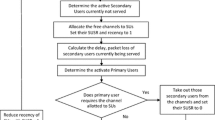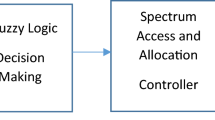Abstract
Spectrum scarcity is one of the major challenges that the modern communication engineers are going through because of inefficient utilization of allocated frequency spectrum. The spectrum scarcity is a problem because there is not enough wavelengths/frequency to match the number of channels which are required to broadcast in a given bandwidth. Therefore, the utilization of available allocated spectrum when licensed users are not in use offers an opportunity as well as challenge, also, to increase the efficiency of spectrum utilization. Cognitive Radio offers a promising solution by reutilisation of unused allocated frequency spectrum. It helps to fulfil the demand of frequency requirement for modern communication system to accommodate more data transmission. In this optimum utilization of reuse of frequency spectrum required optimising algorithms in all parts of Cognitive Cycle. This paper focuses on designing a system based on fuzzy logic with a set of input and output parameters to obtain an optimised solution. A comparative analysis is also carried out among various types of membership functions of input and output on Mamdani Fuzzy Inference System and Sugeno Fuzzy Inference System. The proposed approach is applicable to design a better system model for a given set of rules.

























Similar content being viewed by others
References
Haykin, S. (2005). Cognitive radio: Brain-empowered wireless communications. IEEE Journal on Selected Areas in Communications, 23(2), 201–220.
Mitola, J., & Maguire, G. Q. (1999). Cognitive radio: Making software radios more personal. IEEE Personal Communications, 6(4), 13–18.
Yucek, T., & Arslan, H. (2009). A survey of spectrum sensing algorithms for cognitive radio applications. IEEE Communications Surveys and Tutorials, 11(1), 116–130.
Wang, Y., & Chen, Y. (2014). A comparison of Mamdani and Sugeno fuzzy inference systems for traffic flow prediction. Journal of Computers, 9(1), 12–21.
Kaur, A., & Kaur, A. (2012). Comparison of fuzzy logic and neuro-fuzzy algorithms for air conditioning system. International Journal of Soft Computing and Engineering, 2(1), 417–420.
Shleeg, A. A., & Ellabib, I. M. (2013). Comparison of mamdani and sugeno fuzzy interference systems for the breast cancer risk. International Journal of Computer, Information Science and Engineering, 7(10), 387–391.
Zaher, H., Kandil, A. E., & Fahmy, R. (2014). Comparison of mamdani and sugeno fuzzy inference systems for prediction (with application to prices of fund in egypt). British Journal of Mathematics and Computer Science, 4(21), 3014.
Jain, K., & Soni, A. (2015). Comparision of Mamdani and Sugeno fuzzy inference system for deciding the set point for a hydro power plant dam reservoir based on power generation requirement. International Journal of Engineering, Management and Sciences, ISSN, 2348–3733.
Kansal, V., & Kaur, A. (2013). Comparison of Mamdani-type and Sugeno-type FIS for water flow rate control in a rawmill. International Journal of Scientific and Engineering Research, 4(6), 2580–2584.
MATLAB® (2017). Fuzzy Logic Toolbox™: User's Guide (R2017a). Retrieved April 14, 2017 from https://www.mathworks.com/help/pdf_doc/fuzzy/fuzzy.pdf.
Klir, G. J., & Yuan, B. (2001). Fuzzy sets and fuzzy logic: Theory and application. Upper Saddle River: Prentice-Hall of India Private Limited.
Zadeh, L. A. (1971). Similarity relations and fuzzy orderings. Information Sciences, 3(2), 177–200.
Kumar, D., & Verma, P. (2015). Comparative study of Mamdani & Takagi-Sugeno models for spectrum access in cognitive radio networks. In 2015 IEEE International Conference on Computational Intelligence and Computing Research (ICCI(C). IEEE 2015.
Niyato, D., Wang, P., & Kim, D. I. (2014). Channel selection in cognitive radio networks with opportunistic RF energy harvesting. In 2014 IEEE international conference on communications (ICC), Sydney, NSW (pp. 1555–1560).
Ahmed, E. et al. (2013). Fuzzy-based spectrum handoff and channel selection for cognitive radio networks. In 2013 International conference on computer, control, informatics and its applications (IC3IN(A). IEEE.
Le, H.-S. T., & Ly, H. D. (2008). Opportunistic spectrum access using fuzzy logic for cognitive radio networks. In Second international conference on communications and electronics, 2008 (ICCE 2008). IEEE.
Kaur, P., Uddin, M., & Khosla, A. (2010). Fuzzy based adaptive bandwidth allocation scheme in cognitive radio networks. In 2010 8th International conference on ICT knowledge engineering. IEEE.
Zhang, L., Soong, B., & Xiao, W. (2007). An integrated cluster-based multi-channel MAC protocol for mobile ad hoc networks. IEEE Transactions on Wireless Communications, 6(11), 3964–3974.
Author information
Authors and Affiliations
Corresponding author
Additional information
Publisher's Note
Springer Nature remains neutral with regard to jurisdictional claims in published maps and institutional affiliations.
Rights and permissions
About this article
Cite this article
Tripathi, S., Upadhyay, A., Kotyan, S. et al. Analysis and Comparison of Different Fuzzy Inference Systems Used in Decision Making for Secondary Users in Cognitive Radio Network. Wireless Pers Commun 104, 1175–1208 (2019). https://doi.org/10.1007/s11277-018-6075-9
Published:
Issue Date:
DOI: https://doi.org/10.1007/s11277-018-6075-9




